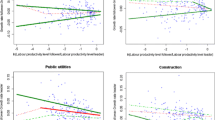Abstract
In this paper, we investigate three aspects of economic growth of European countries: scale, congestion, and technical efficiency. The distinguishing features of the methodology used are, one, countries are exclusively defined in terms of their sectors, and, two, no specific assumptions on any aspect of the growth process (in particular the production function) are required. As such, we can better understand the performances of the countries for each of the three aspects studied, and avoid the drawbacks of specifying the production function. Our results reveal some important patterns useful for policy-makers. Firstly, we highlight the key sectors for each of the three aspects in every country. Next, our analysis reveals that, for each of the three aspects, higher progresses occur more often when more inefficient or non-optimal behaviour is present. Finally, we demonstrate that there is a relationship between these three aspects. All in all, we argue for the need of sector-specific multi-level policies. That is, policies that target the three aspects simultaneously for each sector individually.
Similar content being viewed by others
Notes
In practice, technology axioms (such as monotonicity, convexity, returns-to-scale) are also imposed to avoid trivial reconstructions. See Sect. 2 for more details.
For empirical macroeconomic works using DEA-based methods, refer, for example, to Wu (2001), Kumar and Russell (2002), Henderson and Russell (2005), Enflo and Hjertstrand (2009), Cherchye (2011), Zelenyuk (2011), Zhang et al. (2011), Bampatsou et al. (2013), Badunenko et al. (2013), Song et al. (2013), Wang et al. (2013), Wu and An (2013), Apergis et al. (2015), Wang and Feng (2015), Cantore et al. (2016), Dai et al. (2016), Chen et al. (2016), and Zhou et al. (2017).
This also explains why most of the sector-level empirical studies are focused on a particular or a group of sectors.
Let \(T_{vrs,sdo}\) and \(T_{crs,sdo}\) be the technology under variable and constant returns-to-scale, respectively. By construction, we have that \(T_{crs,sdo}=\{\lambda (\mathbf {X}, \mathbf {Y}): (\mathbf {X}, \mathbf {Y}) \in T_{vrs,sdo}, \forall \lambda >0\}\). This reflects that \(T_{vrs,sdo}\) is included in \(T_{crs,sdo}\), implying that \(Y_{crs,sdo}(\mathbf {X}) \ge Y_{vrs,sdo}(\mathbf {X})\). Intuitively, this reflects that only more technically inefficient behaviour can be found when assuming constant returns-to-scale.
In practice, it is enough to evaluate \(Y_{nirs,sdo}(\mathbf {X}_{ijt})\) (i.e. when assuming non-increasing returns-to-scale) and compare to \(Y_{vrs,sdo}(\mathbf {X}_{ijt})\). If they are equal, decreasing returns-to-scale is present. Otherwise, increasing returns-to-scale is present. Note that \(Y_{vrs,sdo}(\mathbf {X}_{ijt})\) can also be estimated by a linear programme.
Note that it is also possible to construct confidence intervals for the sector-level indicators. This case is not considered in the paper as country-level indicators are the most important indicators, and for the sake of compactness.
The Spearman correlations are 0.9928 (p value of 0) between the weights of the scale and congestion ratios, 0.9859 (p value of 0) between the weights of technical efficiency and congestion ratios, and 0.9850 (p value of 0) between the weights of technical efficiency and scale ratios.
References
Apergis N, Aye GC, Barros CP, Gupta R, Wanke P (2015) Energy efficiency of selected OECD countries: a slacks based model with undesirable outputs. Energy Econ 51:45–53
Badunenko O, Henderson DJ, Russell RR (2013) Polarization of the worldwide distribution of productivity. J Prod Anal 40:153–171
Bampatsou C, Papadopoulos S, Zervas E (2013) Technical efficiency of economic systems of EU-15 countries based on energy consumption. Energy Policy 55:426–434
Barro R (1991) Economic growth in a cross section of countries. Quart J Econ 106:407–443
Barro RJ, Lee JW (2013) A new data set of educational attainment in the world. J Dev Econ 104:184–198
Battisti M, Del Gatto M, Parmeter CF (2017) “Labor productivity growth: disentangling technology and capital accumulation. J Econ Growth (forthcoming)
Baumol W (1986) Productivity growth, convergence, and welfare: what the long-run data show. Am Econ Rev 76(5):1072–1085
Bernard AB, Jones CI (1996) Comparing apples to oranges: productivity convergence and measurement across industries and countries. Am Econ Rev 86(5):1216–1238
Cantore N, Cali M, te Velde DW (2016) Does energy efficiency improve technological change and economic growth in developing countries? Energy Policy 92:279–285
Cherchye L (2011) Using data envelopment analysis to assess macroeconomic policy performance. Appl Econ 33:407–416
Cherchye L, De Rock B, Estache A, Walheer B (2014) “Reducing Energy Use Without Affecting Economic Objectives: A Sectoral Analysis”, in The Next Generation of Economic Issues in Energy Policy in Europe, CEPR Press
Cherchye L, De Rock B, Walheer B (2015) Multi-output efficiency with good and bad outputs. Eur J Oper Res 240:872–881
Cherchye L, De Rock B, Walheer B (2016) Multi-output profit efficiency and directional distance functions. Omega 61:100–109
Chen L, Wang Y-M, Wang L (2016) Congestion measurement under different policy objectives: an analysis of Chinese industry. J Clean Prod 112:2943–2952
Ciccone A, Papaioannou E (2009) Human capital, the structure of production, and growth. Rev Econ Stat 91(1):66–82
Claessens S, Laeven L (2003) Financial development, property rights, and growth. J Finance 58(6):2401–2436
Cook WD, Seiford LM (2009) Data envelopment analysis (DEA)—thirty years on. Eur J Oper Res 192:1–17
Cooper WW, Seiford LM, Tone K (2007) Data envelopment analysis: a comprehensive text with models, applications, references and DEA-solver software, Second edn. Springer, Berlin
Cooper WW, Seiford LM, Zhu J (2004) “Handbook on Data Envelopment Analysis, Second Edition”, Springer Edition
Dai Z, Guo L, Jiang Z (2016) Study on the industrial Eco-Efficiency in East China based on the Super Efficiency DEA Model: an example of the 2003–2013 panel data. Appl Econ 48:5779–5785
Daraio C, Simar L (2007) Robust and nonparametric methods in efficiency analysis. Methodology and applications. Springer, Berlin
Enflo K, Hjertstrand P (2009) Relative sources of European regional productivity convergence: a bootstrap frontier approach. Reg Stud 43(5):643–659
Färe R, Grosskopf S (1983) Measuring congestion in production. J Econ 43:257–271
Färe R, Grosskopf S (1985) A nonparametric cost approach to scale efficiency. Scand J Econ 87:594–604
Färe R, Grosskopf S, Lovell CAK (1994) Production frontier. Cambridge University Press, Cambridge
Färe R, Karagiannis G (2017) The denominator rule for share-weighting aggregation. Eur J Oper Res 260:1175–1180
Färe R, Zelenyuk V (2005) On Farrell’s decomposition and aggregation. Eur J Oper Res 146:615–620
Farrell M (1957) “The Measurement of Productive Efficiency”, Journal of the Royal Statistical Society Series 1, General, 120, Part 3, 253–281
Fried H, Lovell CAK, Schmidt S (2008) The measurement of productive efficiency and productivity change. Oxford University Press, Oxford
Fisman R, Love I (2003) Trade credit, financial intermediary development, and industry growth. J Finance 58:353–374
Hall R, Jones C (1999) Why do some countries produce so much more output per worker than others. Quart J Econ 114(1):83–116
Henderson DJ, Russell RR (2005) Human capital and convergence: a production-frontier approach. Int Econ Rev 46(4):1167–1205
Iscan TB (2015) Allocative inefficiency and sectoral allocation of labour: evidence from U.S. agriculture. Econ Model 43:305–320
Kumar S, Russell R (2002) Technological change, technological catch-up, and capital deepening: relative contributions to growth and convergence. Am Econ Rev 92(3):527–548
Magalhaes M, Afonso O (2017) A multi-sector growth model with technology diffusion and networks. Res Policy 46:1340–1359
Miao J, Wang P (2014) Sectoral bubbles, misallocation, and endogenous growth. J Math Econ 53:153–163
Pasimeni F, Pasimeni P (2016) An institutional analysis of the Europe 2020 strategy. Soc Indic Res 127:1021–1038
Rajan RG, Zingales L (1998) Financial dependence and growth. Am Econ Rev 88:559–586
Rappai G (2016) Europe en route to 2020: a new way of evaluating the overall fulfillment of the Europe 2020 strategic goals. Soc Indic Res 129:77–93
Rodrik D (2013) Unconditional convergence in manufacturing. Quart J Econ 128:165–204
Simar L (2003) Outliers in frontier models: a simple approach. J Prod Anal 20:391–424
Simar L, Wilson PW (1998) Sensitivity analysis of efficiency scores: how to bootstrap in nonparametric frontier models. Manag Sci 44:49–61
Simar L, Wilson PW (2000) A general methodology for bootstrapping in non-parametric frontier models. J Appl Stat 27(6):779–802
Simar L, Zelenyuk V (2007) Statistical inference for aggregate of Farrell-type efficiencies. J Appl Econ 22:1367–1394
Solow RM (1956) A contribution to the theory of economic growth. Quart J Econ 70(1):65–94
Stauvermann PJ, Kumar RR (2017) Productivity growth and income in the tourism sector: role of tourism demand and human capital investment. Tour Manag 61:426–433
Walheer B (2016a) A multi-sector nonparametric production-frontier analysis of the economic growth and the convergence of the European countries. Pac Econ Rev 21(4):498–524
Walheer B (2016b) Growth and convergence of the OECD countries: a multi-sector production-frontier approach. Eur J Oper Res 252:665–675
Walheer B (2017) “Decomposing the Europe 2020 index”, Social Indicators Research forthcoming
Walheer B (2018a) Disaggregation of the Cost Malmquist Productivity Index with joint and output-specific inputs. Omega 75:1–12
Walheer B (2018b) Scale efficiency for multi-output cost minimizing producers: the case of the US electricity plants. Energy Econ 70:26–36
Wang K, Feng C (2015) Sources of production inefficiency and productivity growth in China: a global data envelopment analysis. Energy Econ 49:380–389
Wang K, Lu B, Wei Y-M (2013) China’s regional energy and environmental efficiency: a range-adjusted measure based analysis. Appl Energy 112:1403–1415
Wu Y (2001) Is China’s economic growth sustainable? A productivity analysis. China Econ Rev 11(3):278–296
Wu J, An QX (2013) Congestion measurement for regional industries in China: a data envelopment analysis approach with undesirable outputs. Energy Policy 57:7–13
Zeira J, Zoabi H (2015) Economic growth and sector dynamics. Eur Econ Rev 79:1–15
Zelenyuk V (2011) Aggregation of economic growth rates and of its sources. Eur J Oper Res 212:190–198
Zelenyuk V (2016) Aggregation of scale efficiency. Eur J Oper Res 240:269–277
Zhang X-P, Cheng X-M, Yuan J-H, Gao X-J (2011) Total-factor energy efficiency in developing countries. Energy Policy 39:644–650
Zhou DQ, Meng FY, Bai Y, Cai SQ (2017) Energy efficiency and congestion assessment with energy mix effect: the case of APEC countries. J Clean Prod 142(2017):819–828
Zschille M (2014) Nonparametric measures of returns to scale: an application to German water supply. Empir Econ 47:1029–1053
Author information
Authors and Affiliations
Corresponding author
Additional information
We thank the Editor Subal Kumbhakar and the referee for their comments that have improved the paper substantially.
This work was supported by the National Natural Science Foundation of China under Grant No. 71750110539.
Appendices
Appendix A
We make use of the following abbreviations in Appendix A: Agriculture (A), Mining (Mi), Manufacturing (Ma), Electricity, Gas and Water (EG), Construction (C), Wholesale (W), Transport (T), Public Administration (PA), Education (E), and Health (H); in 19 European countries: Austria (A), Belgium (B), Czech Republic (CZ), Denmark (DK), Estonia (EE), Finland (FIN), France (F), Germany (D), Hungary (H), Ireland (IRL), Italy (I), Luxembourg (L), Netherlands (NL), Norway (N), Poland (PL), Slovakia (SK), Slovenia (SI), Spain (E), and Sweden (S). (Av) corresponds to the average.
Appendix B
We make use of the following abbreviations in Appendix B: Agriculture (A), Mining (Mi), Manufacturing (Ma), Electricity, Gas and Water (EGW), Construction (C), Wholesale (W), Transport (T), Public Administration (PA), Education (E), and Health (H).
See Tables 3, 4, 5, 6, 7, 8, 9, 10, 11, 12, 13, 14, 15, 16, 17, 18, 19, 20, 21.
Appendix C
We make use of the following abbreviations in Appendix C: Agriculture (A), Mining (Mi), Manufacturing (Ma), Electricity, Gas and Water (EGW), Construction (C), Wholesale (W), Transport (T), Public Administration (PA), Education (E), and Health (H).
See Tables 22, 23, 24, 25, 26, 27, 28, 29, 30, 31, 3233, 34, 35, 36, 37, 38, 39, 40.
Rights and permissions
About this article
Cite this article
Walheer, B. Scale, congestion, and technical efficiency of European countries: a sector-based nonparametric approach. Empir Econ 56, 2025–2078 (2019). https://doi.org/10.1007/s00181-018-1426-7
Received:
Accepted:
Published:
Issue Date:
DOI: https://doi.org/10.1007/s00181-018-1426-7




